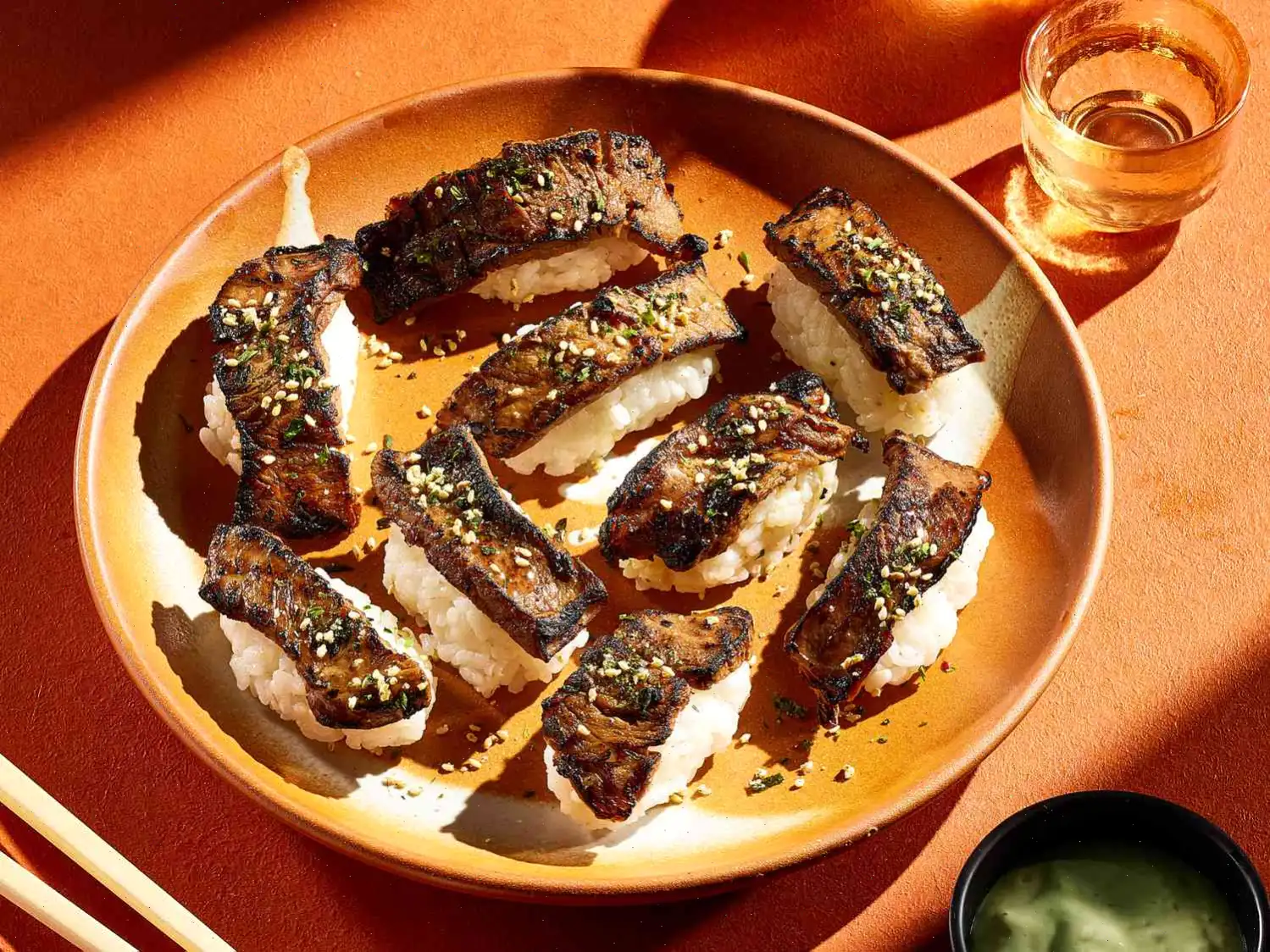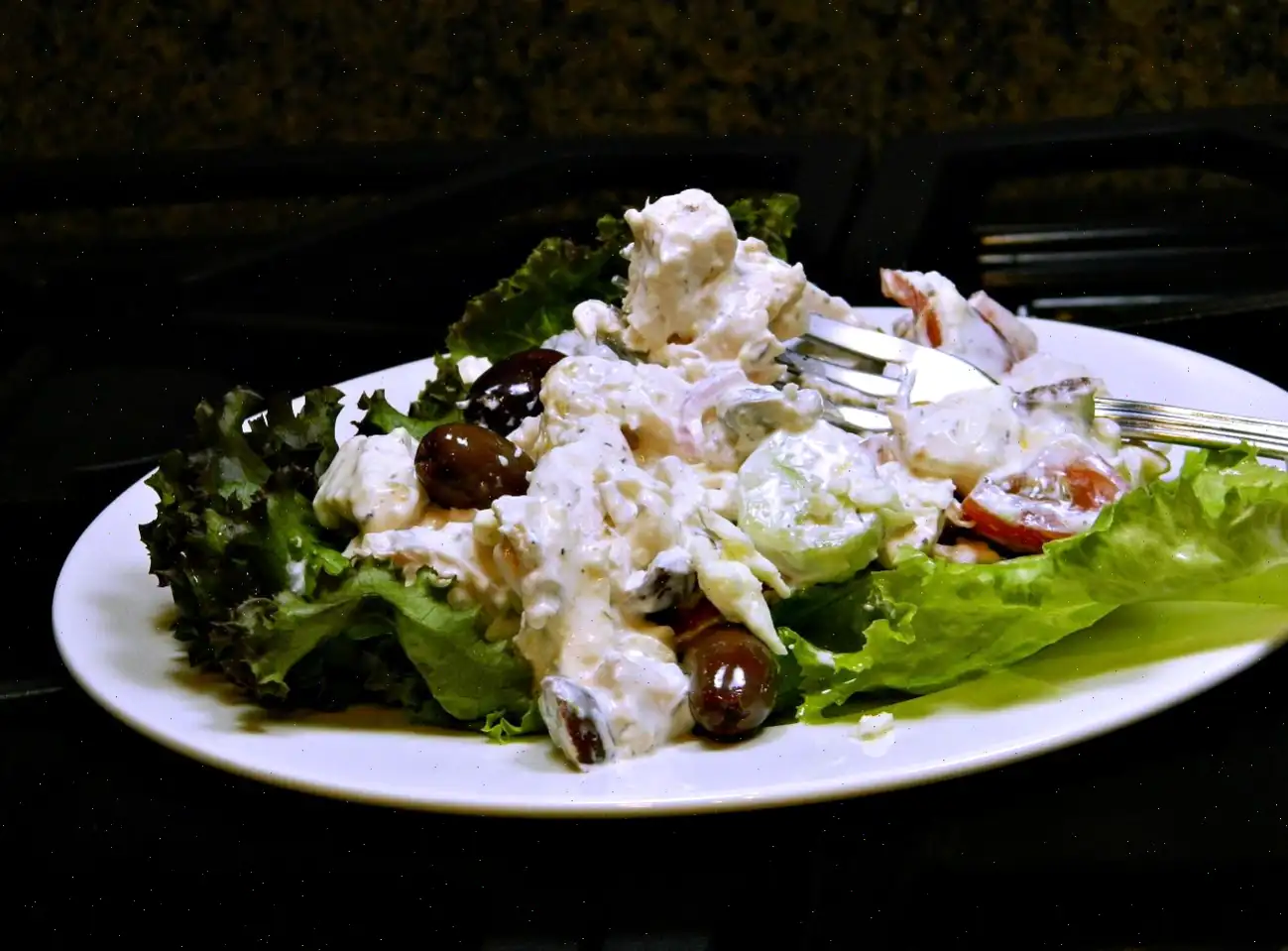
Aburi Steak Recipe
Ingredients
- 1 (12 to 16 ounce) boneless rib eye steak
- 1/2 cup short grain white rice
- 3/4 cup water
- 2 teaspoons rice vinegar
- 1 teaspoon white sugar
- 1/2 teaspoon salt
- 1/4 cup less-sodium soy sauce
- 1 tablespoon pure maple syrup
- 1 tablespoon Asian-style chili paste (such as sambal oelek)
- 1 tablespoon vegetable oil
- 1/3 cup sour cream
- 1/4 teaspoon lime zest
- 2 teaspoons fresh lime juice
- 2 teaspoons wasabi paste, or more to taste
- 2 teaspoons furikake seasoning or toasted sesame seeds
Directions
Step 1: Place the steak on a waxed paper-lined baking sheet. Freeze until just firm, about 1 hour.
Step 2: In the meantime, prepare the sushi rice. Rinse the rice under cold running water, rubbing the grains together with your fingers. Combine the rice and water in a small saucepan. Bring to a boil, then reduce the heat to low. Simmer, covered, until the rice is tender and sticky, about 15 minutes. Remove from heat.
Step 3: Stir together the rice vinegar, sugar, and salt in a small bowl. Mix this into the cooked rice. Cover and let cool for about 45 minutes.
Step 4: Slice the steak thinly against the grain into 24 (1/4-inch-thick) slices. Transfer the steak to a zip-top bag set in a shallow dish.
Step 5: In a small bowl, whisk together the soy sauce, maple syrup, chili paste, and vegetable oil. Pour the mixture over the steak in the bag, seal it, and chill for at least 20 minutes or up to 2 hours.
Step 6: For the sauce, whisk together sour cream, lime zest, lime juice, and wasabi paste in a small bowl.
Step 7: With wet hands, shape the cooled rice into 24 oval-shaped portions (about 1 tablespoon each).
Step 8: Drain the steak slices and discard the marinade. Arrange the steak on a foil-lined baking sheet set on a wire rack.
Step 9: Use a kitchen torch to char the steak slices, turning once, until the desired doneness is achieved, about 5 minutes for the entire batch.
Step 10: Place 1 slice of steak on each portion of rice. Sprinkle with furikake seasoning or toasted sesame seeds and serve with the prepared sauce.
Recipe Tip: When using a kitchen torch, protect your work surface by setting a foil-lined pan on a wire rack beneath the steak.
Nutrition Facts (per serving)
| Amount Per Serving | % Daily Value * |
|---|---|
| Calories | 60 |
| Total Fat | 4g |
| Saturated Fat | 2g |
| Cholesterol | 13mg |
| Sodium | 106mg |
| Total Carbohydrate | 2g |
| Dietary Fiber | 0g |
| Total Sugars | 1g |
| Protein | 4g |
| Vitamin C | 0mg |
| Calcium | 9mg |
| Iron | 0mg |
| Potassium | 54mg |
The Origins of Aburi Steak
Aburi steak is a modern twist on traditional Japanese cuisine, rooted in the technique of "aburi," which translates to flame-seared. Originally, aburi was primarily used for sushi, particularly fatty cuts of fish like salmon and toro, to enhance flavor and texture without fully cooking the item. Over time, chefs began experimenting with other proteins, leading to the adaptation of aburi techniques for high-quality beef. The result is a tender, smoky steak with a delicate balance of charred exterior and soft, juicy interior. This method gained popularity in Japan during the early 2000s and quickly spread internationally, especially in urban dining hubs where Japanese fusion cuisine thrives.
Regional Characteristics
While aburi steak has its origins in Japan, the dish reflects regional variations based on ingredient availability and culinary preferences. In Tokyo and Osaka, chefs often use premium Wagyu beef, lightly marinated in soy, sake, and mirin before searing. In North America and Europe, rib-eye or sirloin cuts are more common, paired with local seasonings like maple syrup or chili paste to add sweetness and spice. The torch-searing technique remains consistent, but the accompaniments, such as sushi rice or flavored creams, vary regionally, giving each iteration a unique flavor profile while maintaining the hallmark caramelized surface.
Differences from Similar Dishes
Aburi steak is distinct from traditional grilled or pan-seared steaks due to its partial searing and focus on minimal cooking. Unlike a standard steak cooked evenly over heat, aburi steaks thin slices are quickly charred using a butane torch, preserving the beef's natural marbling and tenderness. Compared to beef tataki, another lightly seared Japanese beef dish, aburi steak is typically served over sushi rice and may include creative toppings or sauces, emphasizing both texture and presentation. This sets it apart as a visually striking and flavor-rich dish that merges sushi culture with classic steak enjoyment.
Where Aburi Steak is Typically Served
Aburi steak is commonly found in high-end Japanese restaurants and sushi bars, especially those specializing in modern or fusion cuisine. It is often featured on omakase menus, where chefs prepare each piece individually to order. Additionally, it is gaining popularity in casual dining establishments and gourmet takeout spots, where diners seek a restaurant-quality experience at home. The dish is particularly celebrated during special occasions, tasting menus, or chefs tables, where its visual appeal and delicate smoky aroma enhance the overall dining experience.
Interesting Facts
- The aburi technique was originally intended to lightly sear fatty sushi to release oils and deepen flavors without cooking the interior.
- Using a torch allows chefs to control the level of char precisely, creating a customized taste experience for each diner.
- Aburi steak can be paired with a variety of sauces, from citrus-infused creams to spicy chili blends, demonstrating the versatility of Japanese culinary innovation.
- The dish has inspired creative variations, including aburi wagyu sliders, aburi sushi rolls, and fusion appetizers, showing its influence beyond traditional sushi tables.
- While visually similar to seared steak nigiri, aburi steak emphasizes the interplay between rice and meat, combining textures in a unique bite-sized presentation.
You can listen to this recipe in AI audio format. Simply click the play button below to listen to the content in a format that suits you best. It’s a great way to absorb information on the go!








